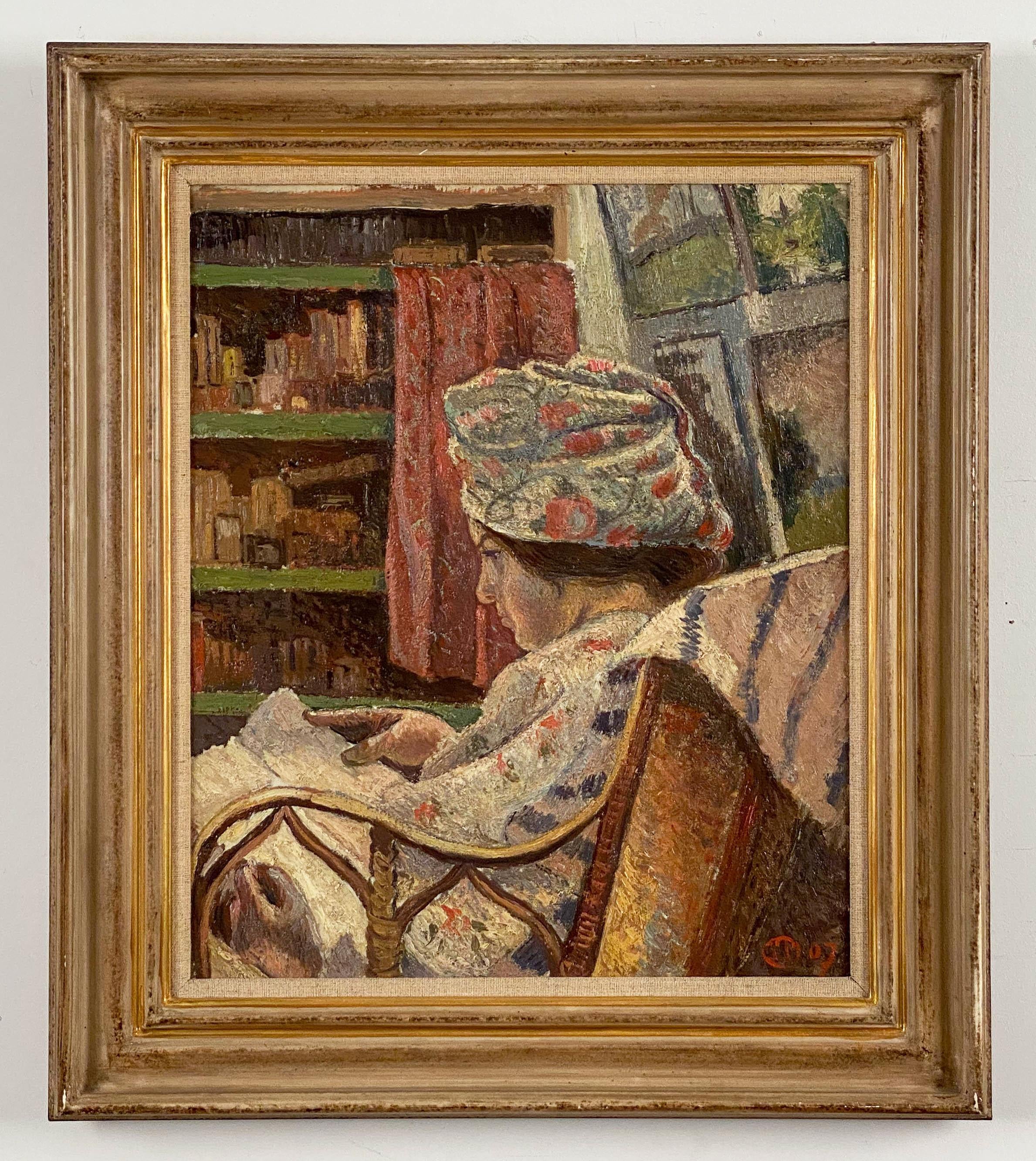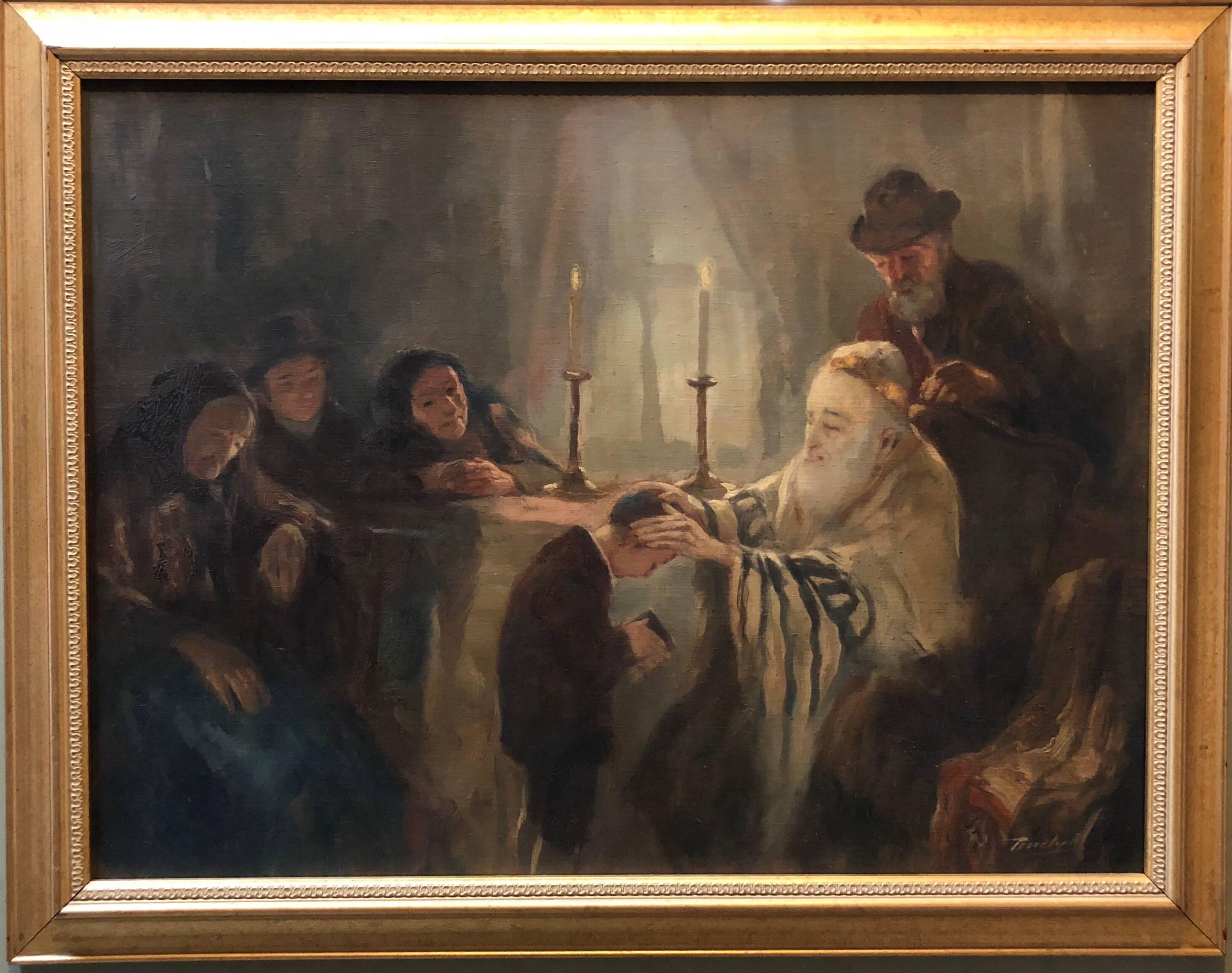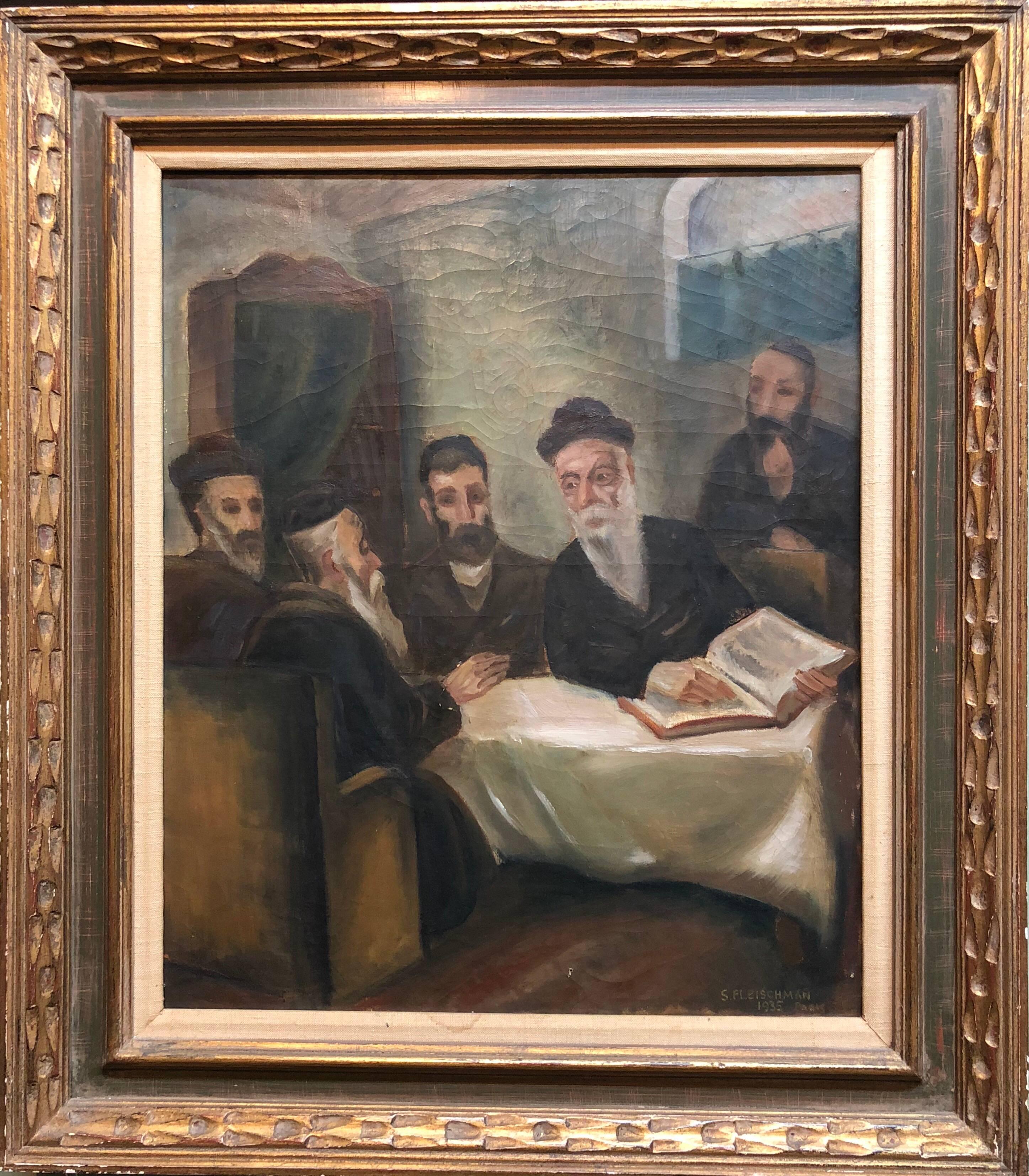Items Similar to Portrait of a Family in an Interior - British 1950's art oil painting
Want more images or videos?
Request additional images or videos from the seller
Charles Ernest CundallPortrait of a Family in an Interior - British 1950's art oil paintingCirca 1955
Circa 1955
About the Item
This interesting British Post Impressionist figurative interior oil painting is by noted artist Charles Cundall and entitled A Conversation Piece. Painted circa 1955 the composition is the interior of a living room with a couple and their two young children, cat and dog. It is full of fascinating details such as the display of porcelain figures in the wall unit, The wonky lampshade on the piano with lovely reflections in its metal base, the slightly shabby walls, the two inviting open doors to other rooms, the way the whole family are looking at the dog (of course!) as it eyes up the tray of tea. Perhaps the dog is in fact the conversation piece of the family and life revolves around him the way the painting does. Is it the artist's family? An excellent example of Cundall's work and life with a dog.
Signed lower right.
Provenance. Gallery label verso.
Condition. Oil on canvas, image size is 30 inches by 25 inches and in good condition.
Frame. Housed in a gallery frame, 39 inches by 34 inches framed and in good condition.
Charles Cundall (1890-1971) - painter, potter and stained glass artist, born in Stratford, Lancashire. After working as a designer for Pilkington's Pottery Company under Gordon Forsyth, Cundall studied at Manchester School of Art, obtaining a scholarship to the Royal College of Art, 1912. After World War I army service he returned to the Royal College in 1918, then from 1919 to 1920 attended the Slade, and furthered his studies in Paris. Cundall travelled widely in several continents and became noted for his panoramic pictures, such as Bank Holiday Brighton, in the Tate Gallery (accession no. NO4700). He was a member of NEAC, RP, RWS and other bodies and was a prolific RA exhibitor. He had first solo show at Colnaghi 1927. He was an Official War Artist in World War II, during which time he was sent to Quebec (1944). In the same year he was elected RA. His wife was the artist Jacqueline Pietersen. His technical facility - especially when working on large panoramic canvases - was remarkable. His pictures are rich with texture, light and movement. He was equally at ease with aerial views, landscapes, seascapes and cityscapes, and was a master of crowd scenes. His work as an Official War Artist has never received the attention it merits.
- Creator:Charles Ernest Cundall (1890 - 1971, British)
- Creation Year:Circa 1955
- Dimensions:Height: 34 in (86.36 cm)Width: 39 in (99.06 cm)Depth: 2 in (5.08 cm)
- Medium:
- Movement & Style:
- Period:
- Condition:
- Gallery Location:London, GB
- Reference Number:1stDibs: LU853113398242
About the Seller
5.0
Platinum Seller
These expertly vetted sellers are 1stDibs' most experienced sellers and are rated highest by our customers.
1stDibs seller since 2018
400 sales on 1stDibs
Typical response time: <1 hour
- ShippingRetrieving quote...Ships From: London, United Kingdom
- Return PolicyA return for this item may be initiated within 14 days of delivery.
More From This SellerView All
- The Serving - British Old Master 18th century oil painting historical interiorBy (Circle of) William HogarthLocated in London, GBA superb British Old Master oil painting which is attributed to circle of William Hogarth and was painted circa 1760. This fine oil painting is in good clean condition and depicts a ...Category
18th Century Old Masters Figurative Paintings
MaterialsOil
- Scottish Interior - Scottish 19th century Victorian art interior oil paintingBy George HayLocated in London, GBA fine Scottish Victorian interior scene by George Hay RSA. A very vibrant stunning Scottish historical interior painting which dates to about 1870. It depicts two women curtsying...Category
19th Century Victorian Figurative Paintings
MaterialsOil
- Interior with Lady Reading - Scottish Edwardian 1910 art portrait oil paintingLocated in London, GBThis superb Scottish Edwardian Impressionist interior oil painting is by noted Scottish female artist Annie Rose Laing. Painted circa 1910, the composition is the interior of a room...Category
1910s Impressionist Interior Paintings
MaterialsOil
- Christ Expelling Money Changers - British 30's surrealist art religious interiorBy Augustus LunnLocated in London, GBPainted by "Modern British" artist Augustus Lunn this oil/tempera on board depicts Christ Expelling the Money Changers. He exhibited widely at The Cooling Galleries and The New Engl...Category
20th Century Surrealist Figurative Paintings
MaterialsOil
- Office Interior - British 1920's Slade School Jewish art oil paintingLocated in London, GBThis superb Impressionist figurative interior oil painting is by Slade School Jewish Victorian born artist Pyzer Cowen, previously Cohen. It was painted circa 1920 and entitled Fleet...Category
1920s Impressionist Interior Paintings
MaterialsOil
- Children in School Room Interior - British Victorian Newlyn School oil paintingLocated in London, GBThis superb, large British Victorian oil painting is by noted Newlyn and Menton artist Arthur Alfred Burrington. It was painted circa 1890 when Burrington was most likely in Newlyn, ...Category
1890s Victorian Interior Paintings
MaterialsOil
You May Also Like
- Girl Reading a BookBy Lucien PissarroLocated in Sheffield, MALucien Pissarro French, 1863-1944 Girl Reading a Book Oil on canvas 18 ¼ by 15 in. W/frame 24 ¼ by 21 in. Signed lower right and dated 1907 Born in Pa...Category
Early 1900s Post-Impressionist Figurative Paintings
MaterialsOil
- "Espagnoles, 1971", 20th Century Oil on Canvas by Artist Emilio Grau SalaBy Emilio Grau SalaLocated in Madrid, ESEMILIO GRAU SALA Spanish, 1911 - 1975 ESPAGNOLES, 1971 signed "Grau Sala" (lower left) signed again, dated and titled "Grau Sala, 1971, espagnoles" (on the reverse) oil on canvas 1...Category
1970s Post-Impressionist Figurative Paintings
MaterialsCanvas, Oil
- At cafe 1950, cardboard, oil, 51x71 cmLocated in Riga, LVAt cafe 1950, cardboard, oil, 51x71 cm The main focus of the artwork is a stylized representation of a cafe scene. The artist's intention is to capture the vibrant and lively atmosphere of a bustling cafe setting. The painting features numerous figures dancing in the background, creating a sense of movement and excitement. The artist's stylized approach involves using bold and expressive brushstrokes, vibrant colors, and abstracted forms to depict the figures and the overall energy of the scene. In the foreground, there is a man sitting behind a table with wine bottles, adding a focal point to the composition. The red interior of the cafe provides a warm and inviting ambiance, adding to the overall atmosphere of the painting. Biruta Baumane...Category
1950s Fauvist Figurative Paintings
MaterialsCardboard, Oil
- Wisdom of King Solomon Rare Biblical Hungarian Judaica Oil PaintingBy Anton PeczelyLocated in Surfside, FLRare Pre World War II (Pre Holocaust) Judaica Art. European Judaic art from this period is exceedingly rare. Péczely Antal Anton 1891 - 1963 Known for his Jewish genre scenes, Chess scenes and other early 20th Century salon style paintings. In the tradition of Moritz Oppenheim...Category
Early 20th Century Post-Impressionist Figurative Paintings
MaterialsOil, Board
- Blessing of the Tzadik (Rebbe) Rare Hungarian Judaica Oil PaintingBy Anton PeczelyLocated in Surfside, FLRare Pre World War II (Pre Holocaust) Judaica Art. European Judaic art from this period is exceedingly rare. Péczely Antal Anton 1891 - 1963 Known for his Jewish genre scenes, Chess scenes and other early 20th Century salon style paintings. In the tradition of Moritz Oppenheim...Category
Early 20th Century Post-Impressionist Figurative Paintings
MaterialsOil, Board
- Rare French, Paris 1935 Judaica Oil Painting Rabbis Studying S. FleischmanLocated in Surfside, FLRare Judaica Art. Jewish genre scene. In the tradition of Moritz Oppenheim, Isidor Kauffman and Maurycy Gottlieb and later of Tully Filmus, Zalman Kleinman and Itshak Holtz the artist captures this Jewish scene with a particular sensitivity. Part of the Ecole De Paris The term "School of Paris" was used in 1925 by André Warnod (fr) to refer to the many foreign-born artists who had migrated to Paris. School of Paris artists were progressively marginalized. Beginning in 1935 art publications no longer wrote about Marc Chagall, just magazines for Jewish audiences, and by June 1940 when the Vichy government took power, School of Paris artists could no longer exhibit in Paris at all. The artists working in Paris between World War I and World War II experimented with various styles including Cubism, Orphism, Surrealism and Dada. Foreign and French artists working in Paris included Jean Arp, Joan Miró, Constantin Brâncuși, Raoul Dufy, Tsuguharu Foujita, artists from Belarus like Michel Kikoine, Pinchus Kremegne, and Jacques Lipchitz, the Polish artist Marek Szwarc and others such as Russian-born prince Alexis Arapoff. A significant subset, the Jewish artists, came to be known as the Jewish School of Paris or the School of Montparnasse. The "core members were almost all Jews, and the resentment expressed toward them by French critics in the 1930s was unquestionably fueled by anti-Semitism." One account points to the 1924 Salon des Indépendants, which decided to separate the works of French-born artists from those by immigrants; in response critic Roger Allard (fr) referred to them as the School of Paris. Jewish members of the group included Emmanuel Mané-Katz, Chaim Soutine, Adolphe Féder, Chagall, Moïse Kisling, Maxa Nordau...Category
Mid-20th Century Post-Impressionist Figurative Paintings
MaterialsOil, Board



